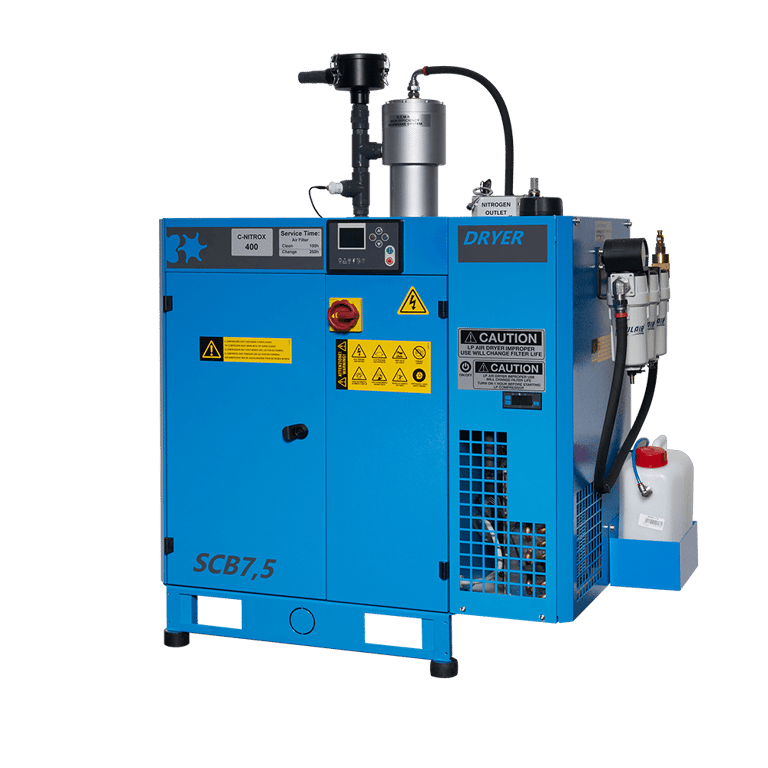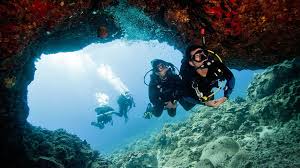Enriched Air - Nitrox Diving
Monz explains the pros and cons of this exciting experience

The nitrox gas product (sometimes known as Enriched Air) has been a part of the recreational diving scene for more than 20 years. Nitrox is the common name for any breathing air gas mixture with an oxygen-enriched concentration higher than 21 percent – the normal concentration of oxygen in breathing air is 21 percent. The standards for Nitrox diving were first established by the National Oceanic and Atmospheric Administration (NOAA).
The Oxygen Enriched Breathing Air mix can also be called Enriched Air Nitrox with the designation of (EAN or EANx). The concentration of oxygen utilised to enrich the breathing air is between 22 and 38 per cent.
With the designation EANX, the “x” refers to the percentage of oxygen in the mix. Example: EAN30 means that there is 30 percent oxygen in the mix. Nitrox mixes come in a variety of ratios depending on what the dive profile requires.
EAN32 and EAN36 have become the most utilised mixture ratios. The recreational limit for nitrox mixes is 40 per cent oxygen. Nearly every major scuba agency/operation has a nitrox dive programme.
There are many misconceptions surrounding nitrox diving. The following will discuss why some scuba divers use nitrox over regular breathing air and what care needs to be taken, and the knowledge of risks that you should be aware of while diving with nitrox.

Benefits of diving with nitrox
1: Longer time on the bottom.
One of the main reasons many people choose to dive with Nitrox is that it allows them to stay underwater for longer. As we all know from our Open Water certification classes, when we dive, the water pressure causes nitrogen from the air we breathe to dissolve in our bloodstream. The deeper we go, the more nitrogen will dissolve. After a certain concentration of nitrogen builds up, we must come back to the surface slowly to avoid either mandatory decompression stops or a case of decompression sickness.
Due to the lower nitrogen concentration in nitrox – when you introduce more oxygen into the breathing air you displace more of the nitrogen gas that is present in breathing air (Example: you increase the oxygen concentration from 21 to 30 percent you remove/displace the nitrogen concentration from 79 percent to 70) - divers can prolong their dive time by absorbing a smaller amount of nitrogen.
According to the NOAA dive tables with no decompression, a diver using standard breathing air can stay a maximum of 60 minutes at 60 feet (18.3m) of seawater. With a diver using EAN32, the diver will be able to stay up to 92 minutes at the 18.3m mark, and a diver with EAN36 can stay at the 18.3m mark for up to 125 minutes.
2: Shorter surface off-gas intervals
For divers in a hurry to return to the diving environment, a benefit of breathing nitrox is shorter surface intervals - a diver using nitrox absorbs less nitrogen on a dive than one who uses standard breathing air. This has great advantages in the time it takes to off-gas on the surface.
According to NOAA's dive tables with no decompression, a diver using standard breathing air will be in the pressure group “H” after a 45-minute dive to 60 feet (18.3m). This means that the diver will have to wait a minimum of five hours 17 minutes to repeat the same dive. Alternatively, a diver using EAN32, will be in pressure group G after a 45-minute dive to 18.3m, which means that they can repeat the same dive after only 53 minutes on the surface.
3: Longer repetitive dive times
Nitrox is beneficial for divers who want to experience more than one dive per day. Due to having absorbed less nitrogen on the first dive, nitrox divers will be allowed to have a longer bottom time on a repetitive dive.
According to NOAA's dive tables with no decompression, a dive to 18.3m for 45 minutes, a diver using standard air can stay at 60 feet for only 14 minutes if he re-enters the water in half an hour, whereas a diver on his second dive performing the same dive profile on EAN32 will be able to stay at 18.3m for 43 minutes.
4: Reduced post-dive exhaustion
Many divers claim to be less tired after dives on nitrox - although it is not scientifically proven. One of the many accepted theories explaining this situation is that lower nitrogen levels in the nitrox breathing gas reduce the amount of micro nitrogen bubbles in the diver’s bloodstream, thus reducing the post-dive exhaustion.
Risks of diving with Nitrox
1. Oxygen toxicity and depth liits
While nitrox diving has many advantages - increased bottom time for no decompression dives, it also has a few concerns.
One of the main ones is oxygen toxicity, which can occur due to the increased levels of oxygen in the mix. Any gas, containing any percentage of oxygen, can cause toxicity at a high enough pressure. For example, a diver utilising standard air would have to go over 60m deep to experience acute oxygen toxicity.
Due to its elevated percentage of oxygen, a danger of nitrox is that it brings this possibility to diving depths experienced by recreational divers.
The two key factors that divers utilising nitrox must consider in order to avoid oxygen toxicity are the amount and the length of exposure. The combination of these two factors is known as the oxygen limit.
The amount of exposure is calculated utilising partial pressures. These are found by multiplying the percentage of oxygen in the mix by the atmospheres of pressure at the planned dive depth.
For example, a diver breathing air (21 percent oxygen) at 40m (5 ATM) is breathing a partial pressure of oxygen (PPO2) of 1.05 (0.21 x 5).
The recreational diving industry generally recommends a maximum PPO2 of 1.4 ATA. This means the maximum operating depth for EAN32 is 34m and EAN36 - 28m.
So, the misconception to the popular belief surrounding the use of nitrox is that nitrox allows divers to dive deeper.
Due to the speed of succumbing to the problem associated with oxygen toxicity, a diver may get little or no warning of the problem, making it harder to survive the problem.
So, to reduce the risk of oxygen toxicity when using nitrox, recreational divers must monitor their depth closely and never exceed the recommended limits or the total exposure calculations to oxygen over a series of dives.
2: The use of nitrox-compatible equipment
Nitrox contains a larger percentage of oxygen, which is highly flammable; the handling and cleaning of nitrox tanks and valves must be completed properly to avoid unintended consequences.
To be sure your diving equipment is up to the standard required for diving with nitrox, it is recommended that special attention is paid to your equipment. Special equipment includes:
⮚ A dive computer - that can be programmed for use with this gas mix
⮚ Be responsible for personally analysing the mixture of oxygen and nitrogen in scuba tanks - it's a good idea to buy an oxygen analyser.
⮚ Recreational divers utilising Nitrox concentrations up to 40%/EAN40 can use their everyday regulators.
⮚ BUT those engaging in technical diving with higher oxygen concentrations must utilise regulators and tanks that have been through a thorough oxygen cleaning process. This process includes and is not limited to special oxygen-compatible lubricants and materials.
⮚ Labelling: Any time a tank is filled with nitrox, it must be properly labelled and marked. The industrial standard is to mark the tank with both a tank wrap - nitrox tank wrap is normally 10-13 cm wide and is green/yellow in colour - and a label or tag to identify the mixture.

Personal responsibility
As with any underwater activity, to get the safest and most enjoyable experience, it is strongly recommended that a reputable nitrox diving course is completed prior to heading out in the water.
For more information on Monz products, visit monz.co.nz



